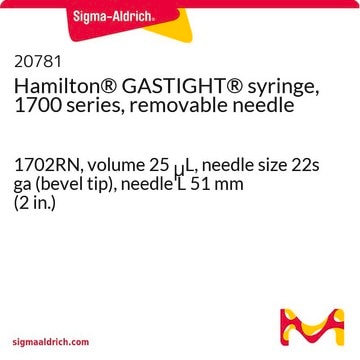20972
Hamilton® GASTIGHT® syringe, 1700 series
1701N, volume 10 μL, needle size 26s ga (bevel tip), needle L 51 mm (2 in.)
Sign Into View Organizational & Contract Pricing
All Photos(1)
About This Item
UNSPSC Code:
41122001
Recommended Products
material
PTFE plunger tip
bevel tip stainless steel needle (point style 2)
needle size
26s ga (bevel tip)
description
Gastight®
feature
needle type N (cemented)
packaging
pkg of 1 ea
manufacturer/tradename
Hamilton 80000
needle L
51 mm (2 in.)
volume
10 μL
Looking for similar products? Visit Product Comparison Guide
General description
Hamilton syringe is available in gas-tight type that minimizes the gas exchange during GC analysis. It gives accurate volume delivery. The plunger is mostly unsurpassed.
Application
Hamilton syringe was used in sampling the headspace gas produced from automated pressure evaluation system for methane analysis using gas chromatography. It has also been used in extraction and injection procedures during GC analysis of essential oil components of Lavandula angustifolia.
Legal Information
GASTIGHT is a registered trademark of Hamilton Co.
Hamilton is a registered trademark of Hamilton Co.
Choose from one of the most recent versions:
Certificates of Analysis (COA)
Lot/Batch Number
It looks like we've run into a problem, but you can still download Certificates of Analysis from our Documents section.
If you need assistance, please contact Customer Support.
Already Own This Product?
Find documentation for the products that you have recently purchased in the Document Library.
Customers Also Viewed
Evaluating effects of tannins on extent and rate of in vitro gas and CH 4 production using an automated pressure evaluation system (APES).
Pellikaan, Wilbert F., et al.
Anim. Feed Sci. Technol., 166, 377-390 (2011)
Hydrodistillation-headspace solvent microextraction, a new method for analysis of the essential oil components of Lavandula angustifolia Mill.
Fakhari, Ali Reza, et al.
Journal of Chromatography A, 1098.1, 14-18 (2005)
Don P. Wolf
In Vitro Fertilization and Embryo Transfer: A Manual of Basic Techniques, 192-192 (2012)
Andrea Dimitracopoulos et al.
Current biology : CB, 30(18), 3687-3696 (2020-08-01)
Proliferating animal cells are able to orient their mitotic spindles along their interphase cell axis, setting up the axis of cell division, despite rounding up as they enter mitosis. This has previously been attributed to molecular memory and, more specifically
Our team of scientists has experience in all areas of research including Life Science, Material Science, Chemical Synthesis, Chromatography, Analytical and many others.
Contact Technical Service











